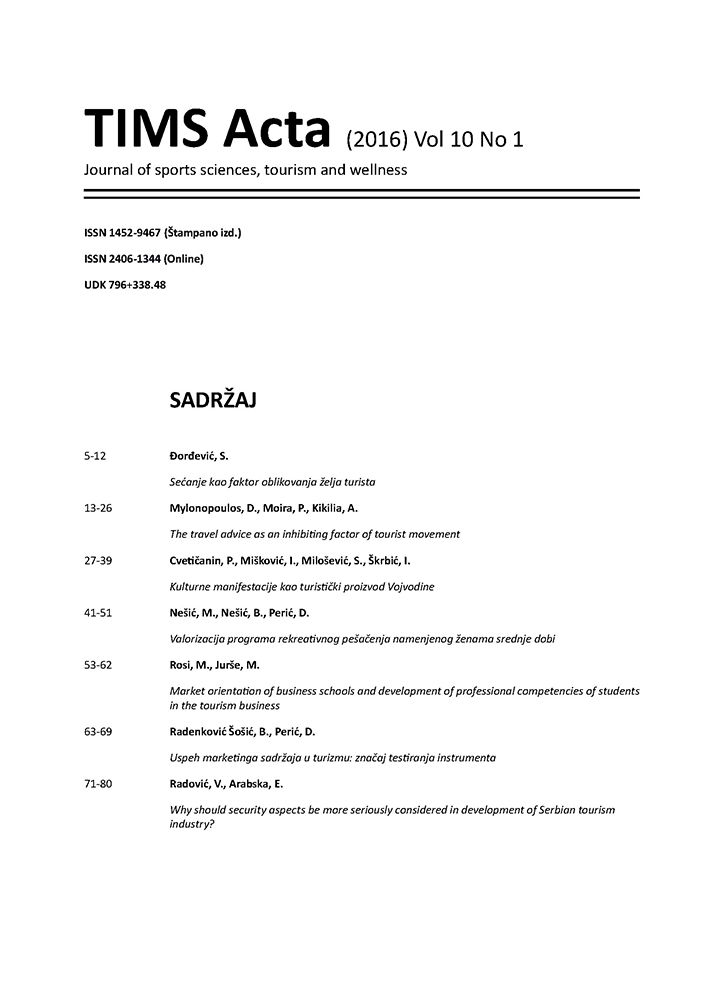CULTURAL EVENTS AS A TOURISM PRODUCT OF VOJVODINA
Abstract
A special place among tourist attractions belongs to those from the field of culture and cultural heritage. In last decades cultural tourism faced a rapid growth on global market and therefore became a subject of numerous studies. Culture in Vojvodina has a long and rich tradition. Centuries of cohabitation inducted mutual cultural influences of many nations and resulted in a rich cultural diversity of expressions and their fruitful interaction.
Today, there is a vast number of local traditional events and festivals in Vojvodina. Some of them exceeded the local market and expanded through the region and beyond. Events in Vojvodina have significant tourism potential, although a majority has a local character with insignificant or no tourist importance. Most of these events are unsustainable as well as spatially and temporally unsynchronized.
Using the results of previous mapping, data collection and focus group research, the aim of this paper is to classify all existing cultural events in Vojvodina and propose the guidelines for their improvement in order to strengthen the cultural identity and cultural tourism product. The proposed steps and guidelines outlined in this paper should lead to improvement of cultural tourism, through strengthening tourism potentials of cultural events in Vojvodina.
Key words: Cultural events, cultural tourism, cultural identity, tourism product, Vojvodina
References
Bianchini, F. (1999). Cultural planning for urban sustainability. In L. Nystrom & C. Fudge (Eds.).(1999). Culture and Cities. Cultural Processes and Urban Sustainability (pp. 34-51). Stockholm: The Swedish Urban Development Council.
Bjeljac, Ž. (2010). Turističke manifestacije u Srbiji. Beograd: Geografski institut „Jovan Cvijić" SANU.
Getz, D. (1997). Event management and Event Touris. New York: Cognizant Communications Corporation.
Mercer, C. (1991). Brisbane’s Cultural Development Strategy: The Process, the Politics, and the Products. In EIT The Cultural Planning Conference. Victoria, Australia: EIT.
Mercer, C. (1991). What Is Cultural Planning? Paper presented to the Community Arts Network National Conference. Sydney, 10 October, 1991.
Perovic, V., Nerandzic, B.; Todorovic, A. (2012). Controlling as a useful management instrument in crisis times. African Journal of Business Management, 6 (6), 2101-2106.
Ritzer G. (1999). Enchanting a Disenchanted World: Revolutionizing the Means of Consumption. London: Sage.
Richards, G. (2013). Events and the Means of Attention. Journal of Tourism Research & Hospitality, 2 (2), 1-5.
Turistička organizacija Srbije. (2014). Kaledndar događaja Turističke organizacije Srbije. Preuzeto sa: www.srbija.travel/kalendar-dogadjaja
Turistička organizacija Vojvodine. (2014). Kalendar manifestacija Turističke organizacije Vojvodine. Preuzeto sa: http://vojvodinaonline.com
Zavod za proučavanje kulturnog razvitka. (2014). Agenda manifestacija Zavoda za proučavanje kulturnog razvitka. Preuzeto sa: http://www.zaprokul.org.rs/AgendaManifestacija/Search.aspx
Zukin, S. (1995). The cultures of cities. London: Blackwell.
- Autori zadržavaju autorska prava i pružaju časopisu pravo prvog objavljivanja rada i licenciraju ga "Creative Commons Attribution licencom" koja omogućava drugima da dele rad, uz uslov navođenja autorstva i izvornog objavljivanja u ovom časopisu.
- Autori mogu izraditi zasebne, ugovorne aranžmane za neekskluzivnu distribuciju članka objavljenog u časopisu (npr. postavljanje u institucionalni repozitorijum ili objavljivanje u knjizi), uz navođenje da je članak izvorno objavljen u ovom časopisu.
- Autorima je dozvoljeno i podstiču se da postave objavljeni članak onlajn (npr. u institucionalni repozitorijum ili na svoju internet stranicu) pre ili tokom postupka prijave rukopisa, s obzirom da takav postupak može voditi produktivnoj razmeni ideja i ranijoj i većoj citiranosti objavljenog članka (Vidi Efekti otvorenog pristupa).

